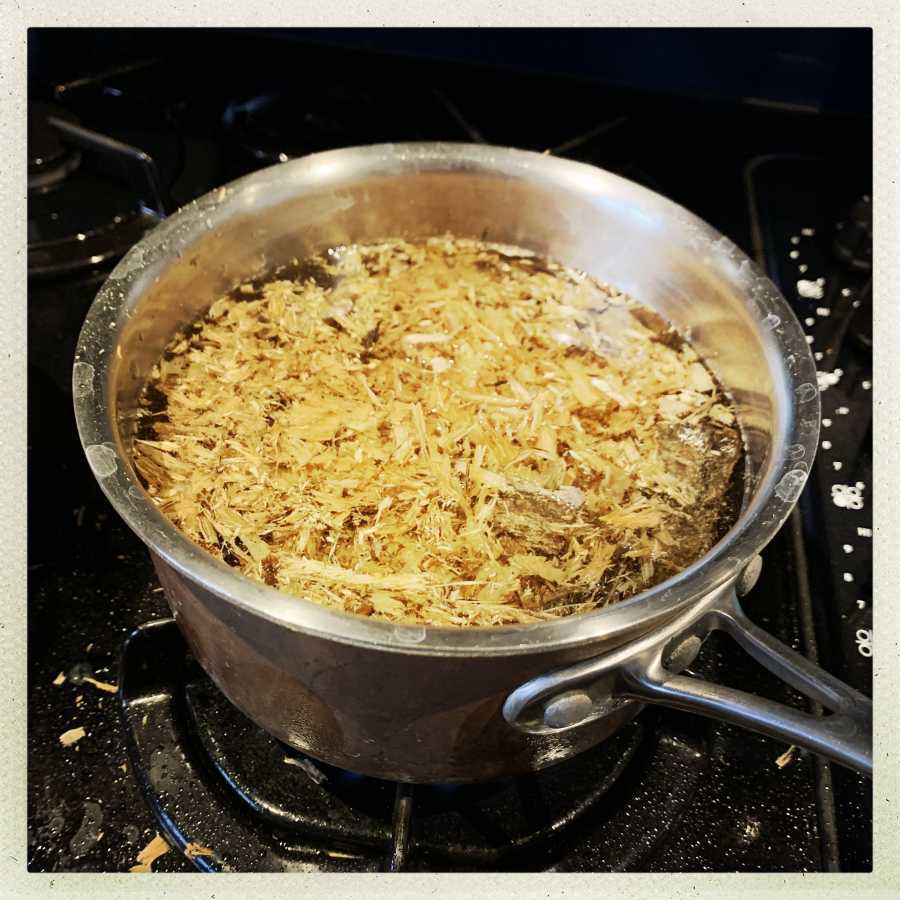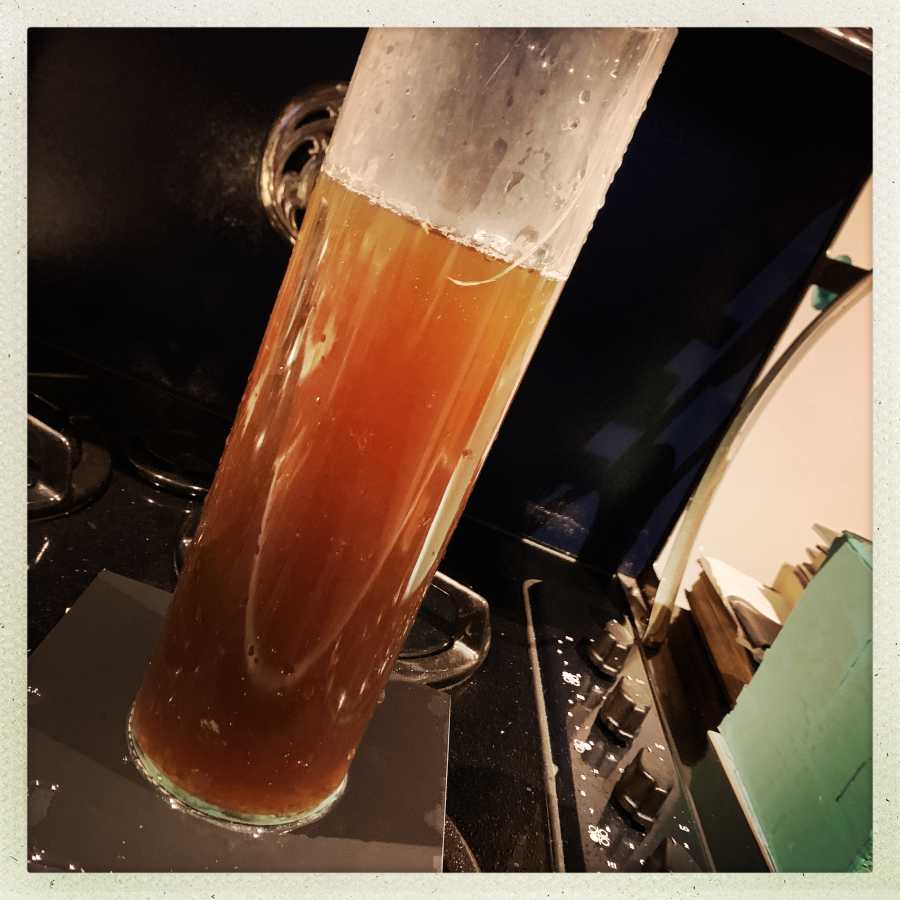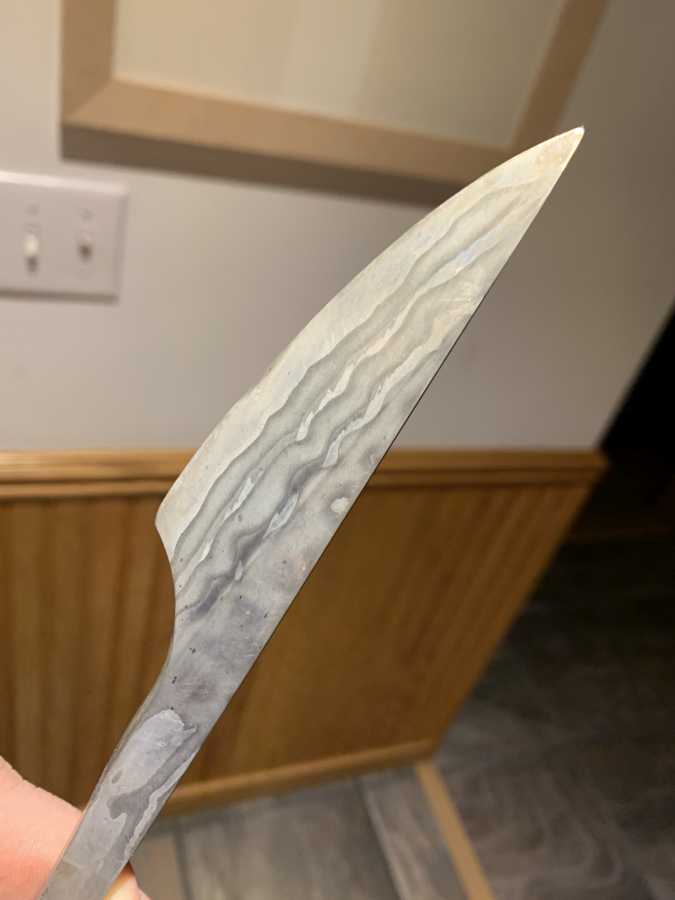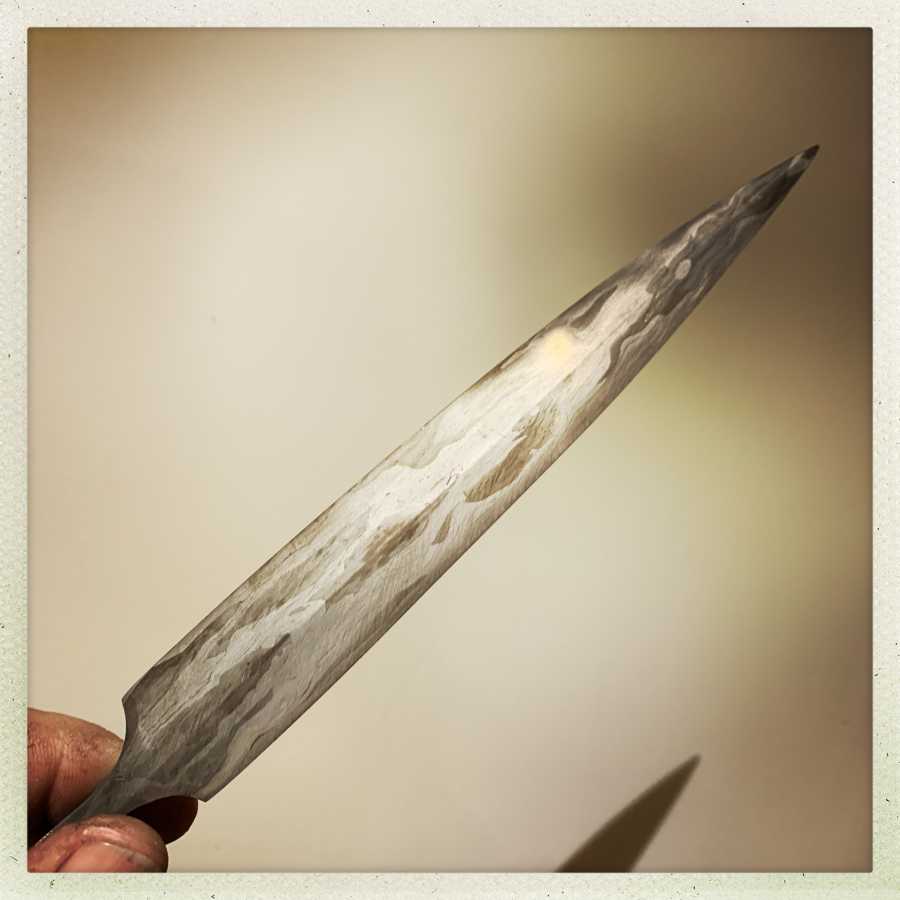In an earlier posting, I asked “why does coffee work for etching knife blades?” It’s all the rage and it does work. [stderr]When I don’t know something, I use a simple algorithm: ask. Nowadays, in the internet era, asking will sometimes collect you a flood of bullshit, or “I don’t know, but…” answers. But I’m fortunate that I have this wonderful and knowledgeable Commentariat(tm) that I can ask. So, I did. And Charly responded thus:
To form magnetite, Fe3O4, various chemicals and usually also heat must be involved. The black that you get from treating the steel with cold FeCl3 is most likely a mixture of several oxides and it is not very stable or durable.
The black you get from coffee is most likely something akin to what you get when you treat steel with tannic acid -click-, i.e. the acidic tannins in the coffee form organic compounds with the iron in the steel.
If you have oak, fir or hickory bark available, you can grind it and test whether it works just as coffee does. I would bet my money that it does.
Do I have oak bark available? Well, I live in Pennsylvania, which is like Texas except with lots more trees, including oak. Out here the road crews just lop chunks off of trees and throw them by the side of the road; wood is generally a low-value commodity (although I saw a power company truck lugging a lovely cherry burl in the back, once) and all I needed to do was drive slowly past a couple piles of cutoffs until I found some oak. I looked for something fresh. Pull over, open the hatch, throw it in, drive off.
How do you shred the bark off a log? Well, that’s really easy if you have a wood lathe! You cut the end straight so you can mount a chuck ring on it, and pop it in the lathe, put down a tarp to collect the shredded bark, and spin it up.

If you look closely at the picture above, you can see the jaws of the chuck locked into the ring, and the screws that hold the ring into the wood. That’s how lathe-workers do stuff nowadays – it’s much much safer than the old spike-and-spinner approach. YOu can see, on my tailstock, I have an extension in the taper, which makes it easier for me to get in close to the action if I need to, without bumping up against the tailstock.
OK, so I got a free oak cup-oid out of the deal. The wood was a bit wet so it’s going to crack but I can chalk it up to “practice.”

Another great thing about wood lathes: nobody comes along and says “OMG what a MESS you have MADE of your SHOP!” That’s what lathes do. When I was a kid my dad had a friend who did wood-turning and his lathe was half-buried in a small mountain of chips, which he cleaned up once a year. It was a fire hazard, but nobody said anything because lathes are just messy and that’s how lathes are.
Look at what a carbide gouge does to oak! It’s kind of scary how the stuff just turns to lacework when the carbide touches it. I thought oak was supposed to be “hard wood.”
So, I scooped a few handfuls of the lower strata (darker) which was mostly shredded bark, bagged it up, and took it home to my kitchen (aka: laboratory of evil #3) then brewed some oak drop soup:

After that, I scooped off the shreds and poured them into my ‘observational etching tube’:

The base is just a piece of ABS plastic I cut on the table-saw, and the acrylic tube is held down with acrylic glue. To water-seal it, as well as to make a safe bottom for knife-points to be dropped on, I poured a layer of silicone liquid down at the bottom. Then, I dropped the whole thing and cracked the top. Anyhow, the tube is really useful since I can leave it sitting in the kitchen sink and check up on it every so often. Some coffee etch fans leave their blades in the coffee for 24 hours, but I am impatient and only gave it 6.
This is what Stabby O’Stabface from the County Stab looked like after 6 hours. When it went it, it was mirror polished with 3000 grid sandpaper.

Score one for Charly! Oak bark is a lot cheaper than coffee and it tastes better than that instant shit, anyhow. Now I have to socialize this idea with knife-makers who will probably do what knife-makers usually do and yell “its tradition!” and keep using much more expensive coffee. Perhaps if I sold oak bark and coffee prices, they’d switch.
One thing that’s interesting is how the metal behaves – sometimes the 1095 goes black and the wrought iron stays bright, and other times it flips around. When you’re using something like 15N20 the 15N20 stays bright, always (the ‘N’ in the designation means it has some nickel in it) So, that’s some science, completed.
This is another one I etched in the oak drop soup:

That’s a letter opener I am making out of compressed motorcycle chain, with a core of 1095. I still need to get the scratches polished out, which is going to be a monster pain in the neck. Working on a blade like that is nasty; you can cut yourself from any side of it very easily. It’s a letter opener, by the way, because “daggers” are illegal in Pennsylvania where it’s a felony to make or carry one, but if I wanted to I could wander around with my Uzi slung across my back, it being a “rifle” and a totally legitimate hunting tool.

It would be a reasonable guess that oak chips are the true tradition, and coffee the parvenu substitute for people that don’t have access to oak chips. Good work!
Some of the laws around weapons in the states really are crazy. Mind some of the laws around weapons in the UK are and have been .. odd. I had a friend in the eighties who was a martial arts-of-some-sort expert who had to have a permit to carry nun-chucks (sp?). He was very careful to carry it at all times, he looked just like a very tall, well built Jimmy Hendrix, and was therefore frequently stopped by our delightful police. The reason I thought the rules strange was that most people attempting to use nun-chucks would be more likely to hurt themselves than anyone else, but I’m likely wrong about that.
Jazzlet@#1:
It would be a reasonable guess that oak chips are the true tradition
I should have sold it as that. “This is how the vikings did it!”
Ale and oak.
That’s a great alternative to coffee. The results speak for themselves I think.
There are some really stupid laws out there.
The laws were aimed at poor people and minorities.
Re: Jazzlet (#1) and nun-chucks
I have great faith in humanity’s ability to cause incredible collateral damage no matter what people do or intend. A novice nun-chuck-wielder facing down the stereotypical mugger would probably hurt themselves, the Poor Old Lady being mugged, the boy scouts coming to her aid and the constable with his whistle, missing noo one except the mugger himself.*
On another note, perhaps requiring expert nun-chuck users to get a permit is a surreptitious way of maintaining a register of the sort people who could do a great deal of damage without traditional (read: obvious) weaponry, and have a disposition and inclination towards the skills that requires. If the pathologist tells the (still bruised) constable that the murder victim died of severe nun-chuck-trauma (non-accidental), that’ll narrow the list of suspects right down. The same could apply to all manner of unusual weaponry, e.g. throwing stars. (Which actually turn out to be illegal in the UK; I just had to check…)
*This being a stereotypical situation, the mugger is of course a he, not a them. He also wears a mask and stripes. If he speaks at all, he affects whatever is considered the local “lower class” accent.
Oh, uhm … [/offtopic]
Experimental science is so much fun and those are some very nice results. I wonder if other vegetation concoctions would work?
Acorns might do it too. I seem to remember that they are so high in tannins that you need to steep them in hot water or some such for a while before you dry them and grind them into flour (or whatever the heck it is you do with them).
I am so glad that it worked because I wanted to try this for a long time. Ever since I learned about etching steel with coffee from you over a year ago – oh, how the time flies – but I did not have an opportunity yet.
ah, uh? I tried to insert a link, it did not work. -click-
It seems that / is not allowed as the last character in a link, even if it is a last character in the actual url. Curiouser and curiouser.
Tannic acid is available in 100g pure form on ebay, so my next experiment with this will be the pure stuff.
I tried to eat an acorn once. It was really, really bitter, I didn’t finish it. I imagine that was the tannins that James was talking about, and I’ve also read about soaking/boiling acorns with multiple water changes before processing them to eat. I’ve also read that some people advise keeping the first change of water for various purposes, mainly because it is so high in tannins.
Another angle, is a lot of tropical freshwater aquarists have used sphagnum peat moss in filters and such, as the tannins released from the peat help soften and acidify the water, and make it more similar to the blackwater river environments that is the natural home of many of those fish in the wild.
Voyager@6>When I was younger, I remember hearing the recommendation to use carbon-steel knives to cut up a bunch of fruit/vegetables during their first usages, and to wipe dry, but not clean them, in order to help develop a protective patina. I’m assuming it’s the various acids and such, but not certain. It seemed to work ok.
I also think it’s absurd that some sort of melee or thrown weapon can be considered illegal while firearms are still considered legal in the same jurisdiction. I guess there isn’t much of a nunchaku, shuriken, or automatic knife lobby…
Acorns are high in tannic acid. I was taught to ‘tan’ (as in tannic acid) leather with acorn hulls. There is one subspecies of oak that is best for this but I forget which one it is. Red oak sounds right for leather and white for eating but IDK. I’ve slept since then. I was told that when selecting acorns I should select the best ones for tanning or eating by taste. The bitter tannic acid is easily detectable as a sharp astringent taste. Just spit it out, it isn’t very toxic, but it can upset the stomach.
All of the acorns are edible after processing. All, as I understand it, have some tannic acid that needs to be removed by mashing, soaking and rinsing (sometimes many times) before drying and pounding to flour that makes a passable flat bread. It wouldn’t be my first choice for food because of the high labor cost and merely tolerable taste but it will keep you going and several native American tribes considered it a staple.
lorn@12
There are a fair number of foods once, or even now, considered staples that would not be my first choice. Either due to the labor involved or the flavor.
James @ 13:
In my limited experience hunger, and a lack of other options, tends to make people appreciate whatever they can get. Then again some people seem to take that imperative waaaaay too far:
https://en.wikipedia.org/wiki/H%C3%A1karl
How this practice came into being is beyond me. I assume some starving Viking came ashore and a scouting party found a shark partially buried in sand, it looked to have been there 6 to 12 weeks and (The part I can’t apprehend) one or more of the Vikings took a good long look, a sniff … and roared … ‘let’s eat’.
Perhaps the problem is I’ve never been that hungry.
lorn@#14:
How this practice came into being is beyond me. I assume some starving Viking came ashore and a scouting party found a shark partially buried in sand, it looked to have been there 6 to 12 weeks and (The part I can’t apprehend) one or more of the Vikings took a good long look, a sniff … and roared … ‘let’s eat’.
I am quite certain alcohol was involved.
I was offered some of the pickled shark when I was in Iceland many moons ago, along with some clear ethanol-rich stuff to wash it down. That was the day I invented my policy on “stunt eating” which is to say “I’m not going to eat things just to amuse you.”
“Oak drop soup.“: I hereby award you one Internet.
Acorns. Oaks generally come in 2 subgenera, colloquially, red oaks and white oaks. The red oaks acorns are high in tannins and taste awful as described. White oaks acorns are quite a bit lower in their tannin content. I’ll sometimes just nibble on them when hiking in the woods. (To identify: white oaks usually have rounded leaves; red oaks have pointy leaves.)
And yes, the Indians knew all about mashing then soaking acorns to draw the tannins out and making a pretty decent flour.
ahcuah@#16:
And yes, the Indians knew all about mashing then soaking acorns to draw the tannins out and making a pretty decent flour.
Wasn’t that “pemmican”? Crushed acorns or maize and some kind of animal fat?
One of the guys in my medieval reenactment group, when I was in college, used to make something like that, and would go around offering it to us at camping events. It was horrible, but it gave me the idea of including a tin of good pate and some canned tuna in my gear.
I’m too lazy to look it up right now, but I thought pemmican was primarily jerky and rendered fat, sometimes with nuts or dried fruit added. I think it was a staple for cold-weather expeditions.
Various people have made flour-like staples from countless things, including acorns, cattail tubers, inner pine bark, etc. I guess processing stuff into a powdery form is more useful/versatile for those things that aren’t great to snack on as found…
In Europe, flour made from acorns was used as food during times of famine. Also, domestic pigs were deliberately taken to oak forests in the fall to feed on acorns. There are allegedly occasionally also so-called “sweet” acorns, which are plants with significantly lower tannin content than normal, tasting almost like hazelnuts or walnuts. But due to the slow growth and extremely late maturation, oaks, unlike hazels and walnuts, were not domesticated – under normal conditions, they are not worth the effort.
The part of oak, that is richest in tannins, is, however, its bark, not the fruit. After bark, also the dark heartwood is rich in tannins.
Very rich in tannic acid are also galls made on oak leaves and twigs by gall wasps. That is why the galls were used to make a durable ink -click-
Charly @ 19:
Perhaps my instructors teaching the tanning of leather were seeking to take it easy on the stands of oaks. Acorns being a self-renewing crop and bark, not so much.
Was’nt ‘oak gall and iron’ the basis for home made ink in rural/wilderness areas? Something about it being one of the first really permanent inks because the chemical action etched itself into the parchment. Making alterations difficult if not impossible to make unobtrusive. The chemical action was so strong that it would, over centuries, eat all the way through the paper/parchment. I remember a photo of a letter from the 1800s where all the loops in the writing had created holes.
Charly@#19:
In Europe, flour made from acorns was used as food during times of famine.
That makes sense, as does feeding them to pigs.
In the south of France there are these big flat thistles. When I was a kid I was horrified to learn that the local farmers used to eat them during WWII. I’ve heard and read of people eating all kinds of crazy things in desperation (shoe leather, rats, Taco Bell, etc) but hearing that described so casually still makes my hair stand up when I recall it.
Nah, try some iron bark. It’s twice as hard as oak, and sinks in water.
I’m turning some now actually, and it’s not too bad. Carbide works best on the sides and a sharp bowl gouge seems to work on the ends